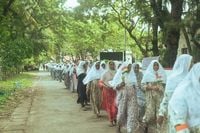In the bustling streets of Bengaluru, a simple yet powerful moment captured on video has reignited a passionate debate about language and identity in Karnataka’s capital. A woman, approached by a street interviewer speaking in Telugu, firmly insisted that he switch to Kannada, the local language, before continuing their conversation. This brief exchange, centered around the Royal Challengers Bengaluru’s recent IPL victory, has since gone viral, sparking widespread discussions about the place of Kannada in the city’s multicultural fabric.
The vox-pop host, speaking in Telugu, asked the woman her opinion about the IPL team’s performance. She immediately interrupted, saying, “Speak in Kannada first. You must ask the question in Kannada.” The interviewer politely explained that he knew only a little Kannada. Undeterred, the woman replied, “Speak in whatever little Kannada you know. That’s fine.” Her calm but firm stance resonated deeply with many Kannadigas who have long voiced concerns about the diminishing use of Kannada in Bengaluru’s public spaces.
Social media users quickly weighed in. One remarked, “What is he even thinking—asking questions in Telugu in Bengaluru? Doesn't he have basic awareness about Kannada being the local language?” Another celebrated the woman’s insistence, noting, “Just a few years ago, such resistance from everyday people was unheard of. This is heartening. Let this become the norm.” Many also praised the interviewer’s respectful response, with one user commenting, “Credit to the Telugu host too—he didn’t escalate or argue. He responded sensibly and acknowledged the woman’s point.”
This viral moment highlights a broader and ongoing conversation about linguistic identity in Karnataka, especially in Bengaluru, a city that draws people from across India and beyond. The incident is a microcosm of the tensions and pride surrounding language use in a diverse and rapidly evolving urban environment.
Meanwhile, the issue of language politics is also playing out on a larger stage with prominent figures weighing in. Actor-turned-politician Kamal Haasan, a pan-Indian cinema icon, recently spoke out against the imposition of Hindi in southern states, including Karnataka. Speaking to PTI, Haasan declared, “I stand with Punjab. I stand with Karnataka. I stand with Andhra.” He emphasized, “Without imposition, we will learn. Don't impose, because this is ultimately education and we must take the shortest route to education… and not put hurdles in its way.”
Haasan’s comments come amid controversy surrounding his latest film, “Thug Life,” which did not release in Karnataka due to backlash over his remark that Kannada was born out of Tamil. The Karnataka Film Chamber of Commerce (KFCC) demanded an apology from Haasan before allowing the film’s release. His production company, Raajkamal Films International, filed a plea in the Karnataka High Court seeking protection for the film’s release. However, after a reprimand from the court regarding his remarks, the producers confirmed that “Thug Life” would not be released in Karnataka.
At 70, Haasan stressed that forcibly imposing a particular language only hampers the learning process. He argued that English remains the most practical language for international communication, noting India’s 350 years of English education. “When you suddenly replace it, it's all over again. You make unnecessarily many people illiterate, especially in Tamil Nadu,” he said. His stance reflects a nuanced understanding of linguistic diversity and education policy in India.
India officially recognizes 22 languages, including Tamil, Kannada, Telugu, Hindi, and many others. The debate over language imposition, particularly the fear of Hindi dominance in non-Hindi speaking states, has long been a sensitive and politically charged issue. The ruling DMK party in Tamil Nadu, for example, has consistently opposed the three-language policy introduced under the National Education Policy (NEP), accusing the BJP-led central government of trying to impose Hindi—an allegation the Centre denies.
Kamal Haasan’s career itself has bridged linguistic divides, with iconic films like “Nayakan,” “Thevar Magan,” “Sadma,” and “Chachi 420” appealing to audiences across language barriers. His recent experiences highlight how language remains a potent and sometimes divisive force in Indian society, affecting everything from film releases to political discourse.
Back in Bengaluru, the viral video of the woman insisting on Kannada is emblematic of a grassroots movement to reclaim and preserve linguistic identity amid rapid urbanization and demographic shifts. It underscores a desire among many Kannadigas to see their language respected and prioritized in public life—whether in media, education, or everyday interactions.
These developments come at a time when Bengaluru is evolving into a cosmopolitan hub, attracting people from all over India. While this diversity enriches the city’s culture, it also raises questions about how to balance inclusivity with preserving local heritage. The Kannada language, with its rich literary and cultural history, remains a core part of Karnataka’s identity, making these debates especially poignant.
As the conversation continues, both on the streets of Bengaluru and in the halls of political power, it’s clear that language in India is not just a means of communication but also a marker of identity, pride, and political assertion. Whether through a viral vox-pop video or a superstar’s controversial remarks, the tensions and hopes around language reflect the complex mosaic that is modern India.
For now, the woman’s simple yet assertive demand for Kannada to be spoken first has become a symbol of a larger movement—one that seeks respect for local languages and cultures amid the country’s vast diversity. It’s a reminder that language is deeply personal and political, shaping not only how people connect but also how they see themselves in the world.

